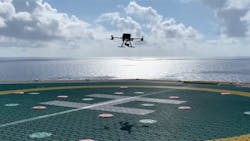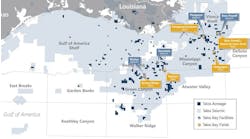Williams, Chevron to facilitate natgas production growth in GoM
Offshore staff
TULSA, Okla. — Williams has executed agreements with Chevron USA Inc. to support natural gas development in the deepwater Gulf of Mexico (GoM).
Williams has agreed to use existing infrastructure to serve increased production from the Blind Faith platform, located 160 miles southeast of New Orleans.
In the deepwater GoM, Chevron is developing the Ballymore tieback to the Blind Faith platform. The project, which involves three production wells tied back via one flowline to the nearby Blind Faith facility, has a design capacity of 75,000 bbl/d of crude oil.
Using existing connections to Blind Faith, Williams will provide offshore natural gas gathering and crude oil transportation services as well as onshore natural gas processing services for the production.
Chevron is the operator of the Ballymore project with a 60% working interest, with co-owner TotalEnergies holding the remaining 40%.
Chevron has proved to be quite busy in the GoM region. See the company's other recent Gulf projects below.
Gulf Coast hydrogen hub
In late January, Chevron announced it is among the founders of a consortium that is working to develop a large-scale hydrogen hub along the US Gulf Coast. Named HyVelocity Hub, the project would include a variety of production and transport infrastructure.
The Gulf Coast is home to one-third of US hydrogen production. That’s 3.5 million metric tons of hydrogen per year. The region also features more than 1,000 miles of hydrogen pipelines and 48 hydrogen production plants.
Chevron looks to develop technology, build infrastructure and stimulate demand for a large-scale hydrogen economy. Some of the components of a hydrogen hub would include end-use applications, infrastructure, pipelines and trucked hydrogen delivery.
The HyVelocity Hub application is being led by GTI Energy, a research and training organization. In addition to Chevron, the project’s partners include the Center for Houston’s Future, the University of Texas at Austin, Air Liquide, Energy Transfer LP, ExxonMobil Low Carbon Solutions, Ørsted, Sempra Infrastructure and Shell.
Drones in the GoM
Using drone sensors offshore is especially tricky because ocean water can confuse emission detection technology, providing false readings.
The situation becomes even more challenging given the size of multilevel oil platforms with layered equipment. Pinpointing emission sources from overhead sensors alone can be like trying to find a needle in a haystack, Chevron said.
To solve these challenges, the company's GoM business unit worked with its San Joaquin Valley business unit in California, which supplied the emissions sensor for mounting on a drone. Ahead of takeoff, Chevron modified the sensor’s laser orientation so it could better identify emissions sources at each level of the platform. The company used the drone to monitor all five of its GoM platforms.
Chevron said offshore monitoring had previously been largely limited to handheld devices.
“We wanted to be able to prove we could use the technology offshore,” said Kathy Sharp, Chevron air quality specialist, who helped facilitate the drone project. “We also wanted to confirm that we weren’t missing any large sources.”
Chevron said drone sensors can be used to detect offshore methane emissions, but they aren’t yet able to quantify those emissions. The company plans to explore other technologies that could provide more specific data to reduce and eliminate methane emissions.
02.17.2023




